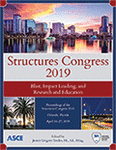Structures Congress 2019
Probabilistic Model for Rebar-Concrete Bond Failure Mode Prediction Considering Corrosion
Publication: Structures Congress 2019: Blast, Impact Loading, and Research and Education
ABSTRACT
Adequate bonding between rebar and concrete is critical to ensuring the reliable performance of RC structures. It is found empirically that bond behavior is affected by many factors, including concrete cover, transverse reinforcement, rebar geometry, concrete properties, etc. While many past studies have focused on the prediction of bond strength, how those factors influence the bond failure mode is not well investigated. The goal of this research is to develop a bond failure mode prediction model considering corrosion. The model development is based on bond testing results of 44 beam-end specimens with various rebar size, corrosion levels, covers, and stirrup confinement. This study adopts logistic and lasso logistic regression, where the failure mode is the categorical dependent variable and the aforementioned factors that could influence the bond behavior are the independent variables. The developed model can be can be further used for corroded RC structure performance evaluation.
Get full access to this article
View all available purchase options and get full access to this chapter.
ACKNOWLEDGMENT
This material is based upon work supported by the National Science Foundation under Grant No. CMMI 1635507. Any opinions, findings, and conclusions or recommendations expressed in this material are those of the authors and do not necessarily reflect the views of the National Science Foundation.
REFERENCES
ACI (American Concrete Institute). "Report on bond of steel reinforcing bars under cyclic loads." (2012).
Almusallam, Abdullah A., Ahmad S. Al-Gahtani, and Abdur Rauf Aziz. "Effect of reinforcement corrosion on bond strength." Construction and building materials 10.2 (1996): 123-129.
ASTM A944. "Standard test method for comparing bond strength of steel reinforcing bars to concrete using beam-end specimens." Annual Book of ASTM Standards (2014).
Böhni, Hans, ed. Corrosion in reinforced concrete structures. Elsevier, 2005.
Castel, Arnaud, et al. "Modeling steel concrete bond strength reduction due to corrosion." ACI Structural Journal 113.5 (2016): 973.
Code, CEB-FIB Model. "CEB-FIB Model Code 2010–Final draft." Thomas Thelford, Lausanne, Switzerland (2010).
Cucchiara, Calogero, Lidia La Mendola, and Maurizio Papia. "Effectiveness of stirrups and steel fibres as shear reinforcement." Cement and concrete composites 26.7 (2004): 777-786.
Hadje-Ghaffari, Hossain, et al. "Bond of epoxy-coated reinforcement: cover, casting position, slump, and consolidation." American Concrete Institute, 1994.
Harajli, Mohamed H., Bilal S. Hamad, and Ahmad A. Rteil. "Effect of Confinement of Bond Strength between Steel." ACI Structural Journal 101.5 (2004): 595-603.
Hussain, S. E., A. Al-Musallam, and A. S. Al-Gahtani. "Factors affecting threshold chloride for reinforcement corrosion in concrete." Cement and Concrete Research 25.7 (1995): 1543-1555.
Kivell, Anton Richard Lean. "Effects of bond deterioration due to corrosion on seismic performance of reinforced concrete structures." (2012).
Lindsey, Charles, and Simon Sheather. "Variable selection in linear regression." Stata Journal 10.4 (2010): 650.
Mangalathu Sivasubramanian Pillai, Sujith. Performance based grouping and fragility analysis of box-girder bridges in California. Diss. Georgia Institute of Technology, 2017.
Orangun, C. O., J. O. Jirsa, and J. E. Breen. "A reevaulation of test data on development length and splices." Journal Proceedings. Vol. 74. No. 3. 1977.
Sajedi, Siavash, and Qindan Huang. "Probabilistic prediction model for average bond strength at steel–concrete interface considering corrosion effect." Engineering Structures 99 (2015): 120-131.
Standard, An ACI. "Building Code Requirements for Structural Concrete (ACI 318-11)." American Concrete Institute. 2011.
Stanish, Kyle David. Corrosion effects on bond strength in reinforced concrete. Diss. National Library of Canada= Bibliothèque nationale du Canada, 1999.
Tibshirani, Robert. "Regression shrinkage and selection via the lasso." Journal of the Royal Statistical Society. Series B (Methodological) (1996): 267-288.
Torre-Casanova, Anaëlle, et al. "Confinement effects on the steel–concrete bond strength and pull-out failure." Engineering Fracture Mechanics 97 (2013): 92-104.
Turk, Kazim, and M. Sukru Yildirim. "Bond strength of reinforcement in splices in beams." Structural Engineering and Mechanics 16.4 (2003): 469-478.
Wang, Huanzi. "An analytical study of bond strength associated with splitting of concrete cover." Engineering Structures 31.4 (2009): 968-975.
Zandi Hanjari, Kamyab, Dario Coronelli, and Karin Lundgren. "Bond capacity of severely corroded bars with corroded stirrups." Magazine of concrete Research 63.12 (2011): 953-968.
Information & Authors
Information
Published In
Structures Congress 2019: Blast, Impact Loading, and Research and Education
Pages: 362 - 372
Editor: James Gregory Soules, McDermott International
ISBN (Online): 978-0-7844-8224-7
Copyright
© 2019 American Society of Civil Engineers.
History
Published online: Apr 22, 2019
Published in print: Apr 22, 2019
Authors
Metrics & Citations
Metrics
Citations
Download citation
If you have the appropriate software installed, you can download article citation data to the citation manager of your choice. Simply select your manager software from the list below and click Download.
